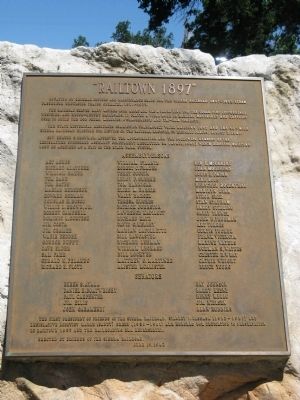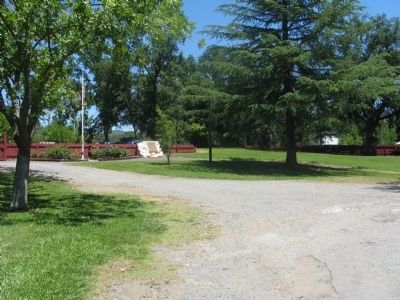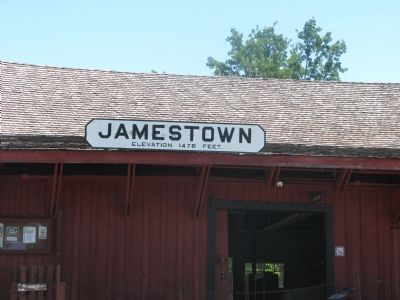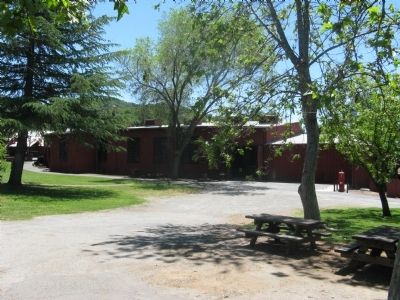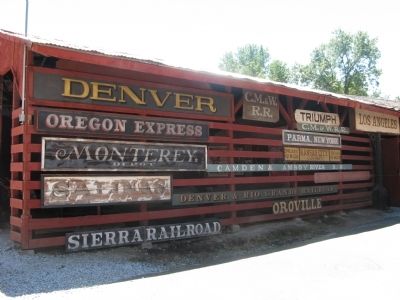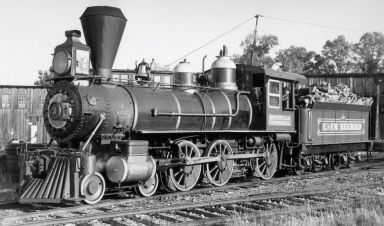Jamestown in Tuolumne County, California — The American West (Pacific Coastal)
“Railtown 1897”
The railroad served many Mother Lode mines and was a trunk line for the Sugar Pine (Pickering), Westside, and Hetch-Hetchy Railroads. It played a vital role in hauling materials and supplies used to build the Don Pedro, Melones, O’Shaughnessy, and Tri-Dam Projects.
The State Historic Resources Commission unanimously voted Railtown 1897 and the 56-mile Sierra Railroad eligible for listing on the National Register of Historic Places, August 7, 1981.
Gov. Edmund G. Brown, Jr. approved the appropriation and the following members of the legislature sponsored Assembly Concurrent Resolution 56 (April, 1981) which directed Railtown 1897 be acquired as a unit of the State Park System.
The first President of Friends of the Sierra Railroad, Stanley F. Cassasa (1912 – 1981) and Legislative Lobbyist Marie (Sandy) Green (1930 – 1981) are honored for dedication to preservation of Railtown 1897 and the railroading era represented.
Erected 1982 by Friends of the Sierra Railroad.
Topics. This historical marker is listed in this topic list: Railroads & Streetcars. A significant historical year for this entry is 1897.
Location. 37° 57.047′ N, 120° 25.023′ W. Marker is in Jamestown, California, in Tuolumne County. Marker can be reached from Sierra Avenue east of 9th Street. Marker is located near the flag pole at the Railtown 1897 State Historic Park. The park may be reached off of Highway 49/108 via 5th Street. Touch for map. Marker is in this post office area: Jamestown CA 95327, United States of America. Touch for directions.
Other nearby markers. At least 8 other markers are within walking distance of this marker. Sierra Railroad (within shouting distance of this marker); Sierra Railway Shops (about 400 feet away, measured in a direct line); Jamestown United Methodist Church (approx. 0.3 miles away); St. James Church (approx. 0.3 miles away); National Hotel (approx. 0.4 miles away); Ramirez – Preston Building (approx. 0.4 miles away); Jamestown (approx. 0.4 miles away); The Emporium – 1897 (approx. 0.4 miles away). Touch for a list and map of all markers in Jamestown.
More about this marker. This is a fee use site and the marker is located inside of the park area.
Regarding “Railtown 1897”. Information posted on museum display:
Built to serve the mining and timber industries of California’s Mother Lode, construction of the Sierra Railway from Oakdale to Jamestown in 1897 brought reliable transportation to the region for the first time. The line was extended to Sonora in 1899. By 1900, the Sierra connected with the West Side Flume & Lumber Company in Tuolumne City.
A 19-mile branch to Angels Camp was completed in 1902 and served neighboring Calaveras County until 1935. Other temporary branches were built to haul construction materials for dams on the Stanislaus and Tuolumne Rivers.
The Sierra established its headquarters and maintenance shops in Jamestown, now site of the Railtown 1897, the Historic Sierra Railway Shops. Most of the structures were built between 1897 and 1922, when the last major additions and improvements were made. When the Sierra converted to diesel locomotives in 1955 a small shop was built in Oakdale. The Jamestown shops remained intact, serving the occasional needs of the motion picture and television industries.
The facility opened for tours and regular train rides in 1971. In 1982, the 26-acre site and collection of historic locomotives and rolling stock were purchased by the State of California for inclusion in the State Park System, thus preserving one of North America’s last surviving steam-era railroad facilities.
Railtown 1897 is operated by the California State Railroad Museum, a part of the California Department of Parks and Recreation
The Sierra Railroad has been one of Hollywood’s favorite locations for nearly 80 years. Beginning with the filming of a silent serial in 1919, Sierra’s trains have been featured in well over 200 productions ranging from big-budget Westerns to television commercials. Among the dozens of motion pictures filmed here were The Virginian in 1929, High Noon in 1952, Bound for Glory in 1976, Back to the Future III in 1990, and Unforgiven in 1992. Television series including “Gunsmoke,” “Petticoat Junction,” “Bonanza,” and “Little House on the Prairie” have featured the trains of the Sierra Railroad.
Although several Sierra locomotives have been used in films over the years, No.3 is the line’s undisputed star. It has appeared in more pictures than any other engine in the world. Built in 1891 and purchased by the Sierra in 1897, the “three-spot” is perhaps best known to the general public as the “Hooterville Cannonball” – the locomotive of the popular 1960s television series “Petticoat Junction.”
Number 3’s classic design allows it to be easily adapted to various eras through the use of “make-up.” Different styles of smokestacks and headlights, as well as paint and lettering appropriate to a film’s setting are applied. In addition, the oil-burning No.3 is often seen with a wood pile covering the oil tank on the tender, a cosmetic feature meant to give the engine an older appearance.
[ Sierra #3 has recently undergone a total restoration and was out of commission for 14 years. See “Also See”
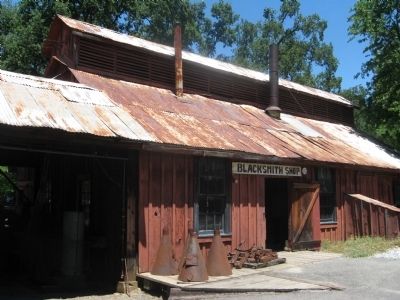
Photographed By Syd Whittle, June 13, 2010
5. The Blacksmith Shop
This is the original blacksmith shop used by the railroad. Parts and tools needed to keep the locomotives and cars operating were created here over hot forges. In later years, it was leased to a company that used the building to make leaf springs. It has been re-supported inside by the State Architectural Office and put back into operating condition.
Also see . . .
1. Railtown 1897. The official website of the State Historic Park with links to additional information. The California State Railroad Museum (CSRM), headquartered in Old Sacramento, assumed responsibility for Railtown 1897 State Historic Park on July 1, 1992. (Submitted on June 27, 2010.)
2. Sierra No. 3. Wikipedia article (Submitted on January 3, 2021, by Larry Gertner of New York, New York.)
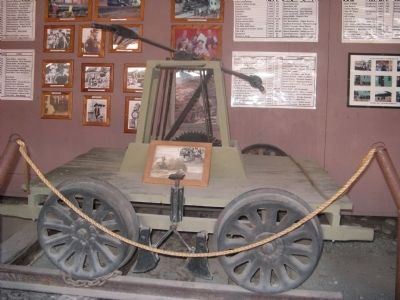
Photographed By Syd Whittle, June 13, 2010
7. John Wayne's Hand Car
This is a replica of the hand car used in John Wayne's first movie - the 1936 Conflict. It was filmed in part at Jamestown and along the tracks of the Sierra R.R. It was also used in a three part episode of Gunsmoke in 1971. Both the hand cart and Sierra No.3 were used in the episode which was about a train robbery of Army gold.
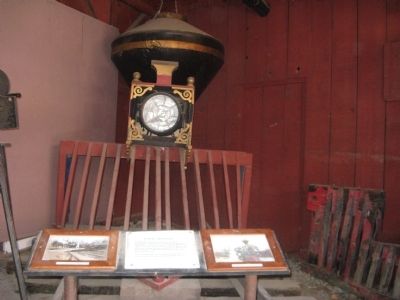
Photographed By Syd Whittle, June 13, 2010
8. Stack #5 - Light and Pilot
From the 20th Century Fox Collection. The date of the construction is unknown. It was acquired by Shortline Enterprises in 1971; moved here in 1976 and abandoned in 1986. It was first used on Locomotive #3 in 1992. It was used most recently on the #2 Locomotive for the movie A Work of Giants - a BBC documentary about the Transcontinental Railroad. The locomotive light and cowcatcher (pilot) were also used on the No.2 for the recent BBC movie.
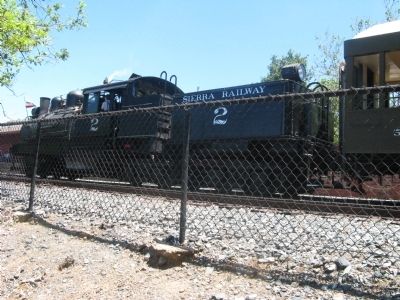
Photographed By Syd Whittle, June 13, 2010
9. Locomotive #2 Returning From an Excursion Trip
Built in 1922 for the Hutchinson Lumber Company at Feather Falls, California, this "SHAY" was their road number 2. Later she became Feather River Railway's #2, owned by Georgia Pacific's Feather River Lumber Company. After the abandonment of the Feather River Railway in the mid-1960's, the #2 was acquired by the State of California for static display at the Oroville Dam. The locomotive was moved to Jamestown in 1975 as extra power for Sierra's ever growing excursion trains. This is the third #2 on the Sierra Railway, the first being a 4-4-0 used prior to 1900 for constuction on the railroad and the second #2 was a 0-6-0 which was off the roster by 1918. Currently #2 is the largest "SHAY" operating in California.
Credits. This page was last revised on January 3, 2021. It was originally submitted on June 26, 2010, by Syd Whittle of Mesa, Arizona. This page has been viewed 2,127 times since then and 56 times this year. Photos: 1, 2, 3, 4, 5, 6, 7, 8, 9, 10. submitted on June 27, 2010, by Syd Whittle of Mesa, Arizona.
